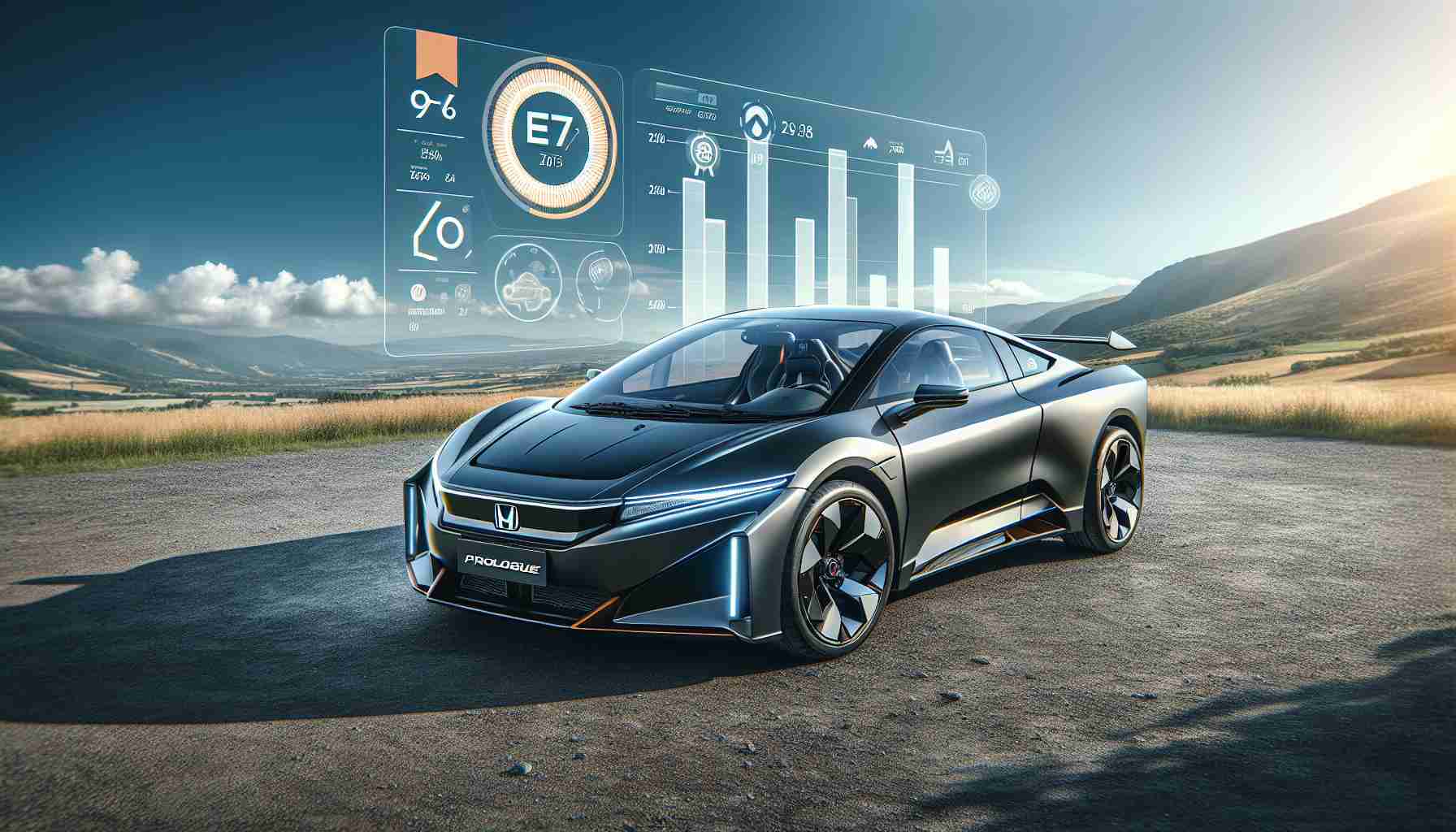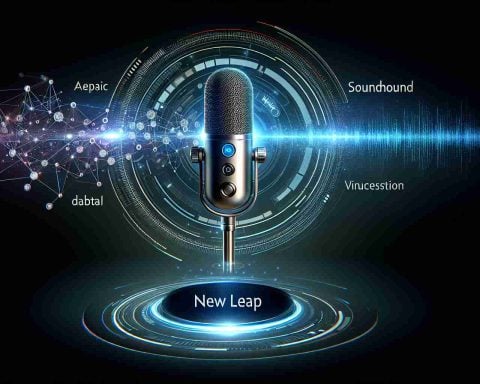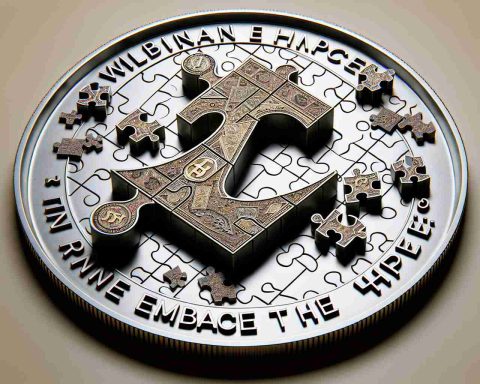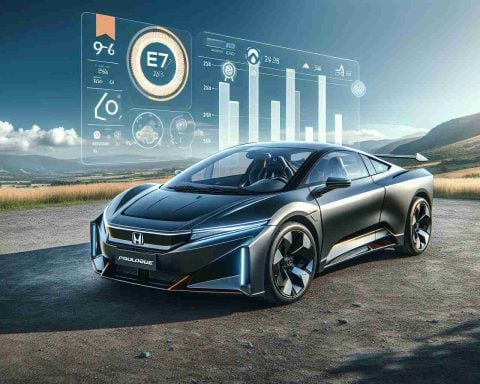- The Honda Prologue has emerged as a leader in the U.S. EV market, topping January 2024 sales with 3,744 units sold.
- Ford’s Mustang Mach-E experienced a 173% increase in January sales, setting new records despite declines in other models.
- Hyundai’s Ioniq 5 achieved third place in January, with a 54% sales boost.
- The Kia EV6 and EV9 secured the fifth and sixth spots in sales, respectively.
- Overall, EV sales soared to nearly 133,000 in December, signaling significant consumer interest.
- Drivers are incentivized by current EV tax credits, as looming changes prompt them to maximize benefits.
- Technological advancements are making electric vehicles more affordable, accelerating the transition from traditional fuel vehicles.
- The growing trend underscores a decisive shift toward electric transportation in the U.S. market.
An unexpected contender is shaking up the electric vehicle landscape in America. The Honda Prologue, launched in March 2024, has surged ahead, claiming the top spot in January EV sales with 3,744 vehicles sold. This bold performance crowns its startling ascent from last year, where it ranked as the seventh highest-selling electric car in the nation, moving over 33,000 units.
Ford’s Mustang Mach-E also made waves, notching a record-breaking January with sales swelling 173% compared to the previous year. Despite a dip in sales for Ford’s F-150 Lightning and E-Transit van, the automaker still managed to secure January records, highlighting shifting consumer preferences.
Meanwhile, Hyundai’s Ioniq 5 continued its climb with a robust 54% increase, securing third place. Not to be outdone, Kia flexed its muscle with the EV6 and EV9 earning respectable fifth and sixth positions, respectively.
Although titans like Tesla and GM keep their numbers under wraps, the trend is crystal clear—more Americans are driving electric. Data indicates that EV sales hit nearly 133,000 in December, breaking records and proving that the electric revolution is not just a flash in the pan.
This surge isn’t solely driven by eco-conscious choices; financial incentives are at play too. With looming changes to EV tax credits under the current administration, buyers are hastily cashing in on existing benefits. Additionally, the advancing technology promises more affordable electric options, fueling the shift from gas-guzzlers to eco-friendly alternatives.
For those considering the switch, the message rings loud and clear: the future is electric, and the time to participate is now.
Why the Honda Prologue’s Success is a Game-Changer for the EV Market
Electric Vehicle Market Overview and Trends
The electric vehicle (EV) market is experiencing a rapid transformation, driven by technological advancement, environmental consciousness, and favorable policy incentives. The Honda Prologue’s unexpected surge in sales is indicative of market shifts favoring diversity in player choices and preferences beyond traditional leaders like Tesla.
Market Forecasts & Industry Trends
According to recent studies, the global EV market is expected to grow at a compound annual growth rate (CAGR) of 29% from 2021 to 2030 (Allied Market Research). This growth is attributed to technological innovations, decreasing costs of lithium-ion batteries, and more stringent emissions regulations.
The introduction of models like the Honda Prologue signals an increasing trend towards more affordable and varied EV options. Automakers are investing in product lines that cater to different segments, ultimately swelling the market with diverse offerings across price points.
Real-World Use Cases and Consumer Interest
The case of the Honda Prologue resonates with growing consumer interest in practical, budget-friendly electric vehicles equipped with reliable technology. This model has appealed to American consumers due to a balance of price, features, and brand reputation.
Another real-world example is the Ford Mustang Mach-E. Its dramatic sales increase suggests that consumer interest is diversifying towards performance and brand legacy within the EV space, marking a shift from early adopters to mainstream buyers comfortable with established automotive brands.
Reviews & Comparisons
Honda Prologue vs. Competitors
– Performance: The Honda Prologue is praised for its balanced performance and range, often compared favorably to mid-size EV offerings like the Hyundai Ioniq 5.
– Features & Pricing: Positioned as an affordable EV option, the Prologue benefits from Honda’s established reputation for reliability and positive customer service experiences.
Conversely, alternatives like the Ford Mustang Mach-E offer sportier aesthetics and performance specifications, thereby capturing a different segment of the market.
Controversies & Limitations
Despite the optimism, the EV market is grappling with infrastructure challenges. Charging networks require expansion to meet increasing demand. Another limitation is the dependency on supply chains for battery components, which could face constraints in case of geopolitical tensions.
Environmental concerns related to mining operations for EV battery materials are also rising, prompting debates around sustainability.
Security & Sustainability
In terms of sustainability, increased scrutiny on production practices has propelled automakers to adopt more eco-friendly manufacturing and recycling practices. Honda, for example, has committed to achieving carbon neutrality by 2050.
Regarding security, EV manufacturers continuously improve software components to mitigate risks associated with cybersecurity threats. Regular updates and robust encryption standards in newer models help protect consumer data.
Insights & Predictions
Given current trends, the EV market will likely see accelerated innovation in battery technology and increased adoption of renewable resources within production processes. Improvements in vehicle autonomy and artificial intelligence may also become significant selling points.
Actionable Recommendations and Life Hacks
1. Leverage Tax Credits: Potential EV buyers should investigate federal and state tax incentives, which can reduce overall purchase costs.
2. Home Charging Installations: Investing in a home charger can ensure convenience and potentially lower electricity costs.
3. Research Warranty and Maintenance Plans: New EV owners should take advantage of extended warranty options that may cover costly electronics.
For those on the fence, engaging with community test drives or rentals of different EV models can offer firsthand experience before committing to a purchase.
In summary, as the landscape evolves, consumers should stay informed about advancements and policy changes while considering the broader environmental impact of their choices.
For a comprehensive insight into changing market dynamics and EV offerings, visit Motor Trend.


















